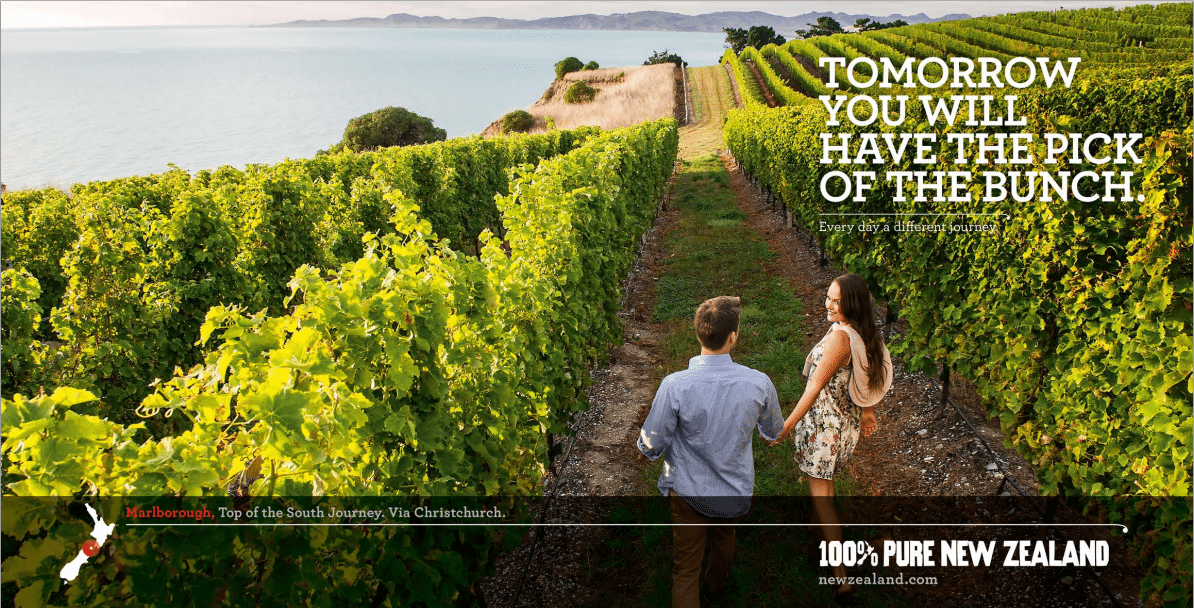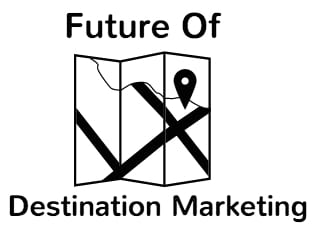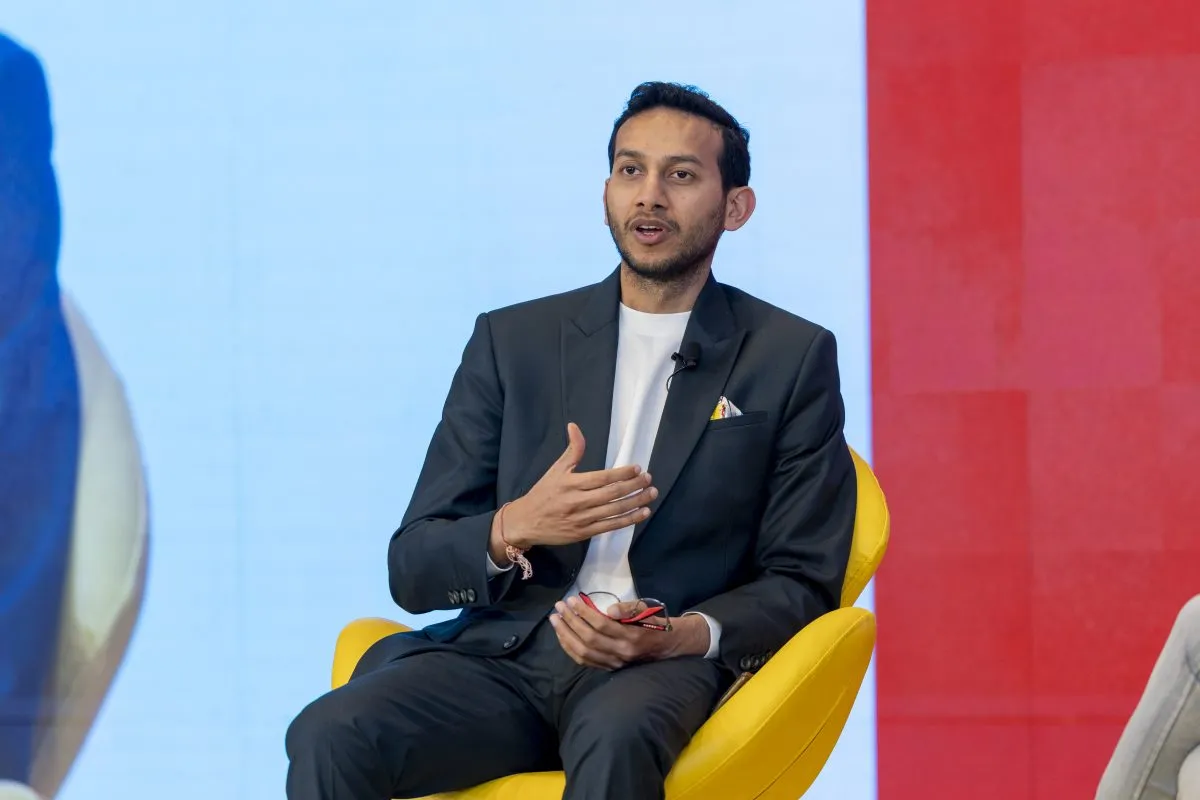Interview: Tourism New Zealand CEO on Smarter Digital Marketing

Skift Take
- Images from a recent Tourism New Zealand print campaign that ran in Australia.
- Images from a recent Tourism New Zealand print campaign that ran in Australia.
- The 100% Pure New Zealand logo.
- Tourism New Zealand CEO Kevin Bowler.
Editor’s Note: Skift is publishing a series of interviews with CEOs of destination marketing organizations where we discuss the future of their organizations and the evolving strategies for attracting visitors. Read all the interviews as they come out here.
This continues our series of CEO interviews that began with online travel CEOs in Future of Travel Booking (now an e-book), and continued with hotel CEOs in the Future of the Guest Experience series (which is also an e-book).
Long an infrequently visited country of untouched outdoor landscapes, New Zealand burst onto the international scene when the minds behind two remarkable movie franchises -- the Lord of the Rings and Hobbit trilogies -- decided to produce their films in the country more than 13 years ago.
The series brought New Zealand into the living rooms of viewers across the world. The tourism board has since capitalized on by making as many connections as possible between the real-life destination and fictitious Middle Earth in movie-goers’ and travelers’ minds.
New Zealand’s national carrier Air New Zealand also jumped on the Middle Earth craze with a series of in-flight safety videos and advertisements. These efforts were complemented by giant art installations at airports.
As a result of the films as well as growing awareness of the destination and increased international travel, a record 2.8 million visitors arrived in New Zealand between March 2013 and 2014, a 5.4 percent increase over the same 12-month period one year earlier. It's seen growth despite an earthquake that destroyed key parts of the city of Christchurch in 2011.
The top source markets for that time period are Australia, China, United States, UK and Germany of which Germany (+14.5%) and China (+14%) have experienced the most growth.
Tourism New Zealand Kevin Bowler knows that the time and money it takes travelers from most markets to travel to the country will forever be a challenge despite its recent rise in popularity. As a result, he’s become laser focused on which groups of travelers he goes after and the kinds of stories his organization tells about the destination.
Skift recently spoke to Bowler about the country’s unique and targeted marketing strategies, how his and other destination marketing organizations can more effectively prove their value, and how he plans to build on film tourism lessons for future success.
An edited version of the interview can be found below:
Skift: What are the primary marketing channels that you use today to promote New Zealand worldwide?
Kevin Bowler: It starts with a really clear understanding of who we're trying to reach. In each market, we have defined audiences that we're addressing. Marketing New Zealand remains quite a niche proposition globally.
We get about 2.8 million visitors a year, which is pretty small in comparison to a lot of major destinations. They tend to be attracted to New Zealand's outdoors, spectacular scenery and nature. They are not your average international traveler; they are not looking for an ordinary destination.
We use a lot of digital media to reach that group. We're very active with Google. We spend quite a bit on search engine marketing and use their display network to leverage intelligence on what people are searching and to identify people who are interested in the types of activities that our destination does really well.
We're basically looking to connect our assets and stories with people who are interested in the sort of destination that New Zealand represents. Rather than thinking about mass channels, we spend much more on finely targeted channels.
Skift: In terms of digital marketing channels, which platforms perform the best or do you rely on the most?
Bowler: We have quite a strong reliance on our website NewZealand.com and that gets about 20 million visits a year. It’s a large and complex site and a good way for people to find out more about New Zealand and connect with someone who can tell them about various experiences. We’re also very active through Facebook and Sino Weibo. Our primary marketing vehicle is our website because that’s where people come for authoritative information about the destination.
Skift: Can visitors book travel through NewZealand.com?
Bowler: There are connections to several thousand businesses where they can book, but we purposefully did not set the site up as a booking site. It’s much more of an information and inspirational site.
Skift: Looking at destination marketing across these platforms, what trends have you seen in terms of the tone and style of content as well as how it is created and then communicated to travelers?
Bowler: Changes are happening much faster than we would have anticipated a couple of years ago. One of them is the trend towards video. People want to consumer a lot of destination video content and we’re producing a lot more of it. Even two years ago, the level of interested in video was much lower than it is today.
The other trend that overlaps with video is access to the site via mobile devices and tablets. It is growing really fast and we expect access from mobile devices to soon be bigger than access from PCs.
Skift: Interesting. Let's shift gears a bit to travelers. Once they're in a destination, we're seeing that travelers today are relying more on their mobile phones, they're researching more before a trip, they're reading user generated content. How do you think that destination marketing organizations are evolving to adapt to today's traveler habits?
Bowler: We support a nationwide network of visitor outlets that provide face-to-face advice to people. We also have an app that connects people with activities based on their current location. We find that most people, even while in New Zealand, still go back to the website because that has the most comprehensive set of activity and accommodations listings. If they arrive in a new town or are looking for particular activity, this tends to be their favorite approach.
Skift: What about building a the relationship with customers once they're in the destination? Are you talking to travelers once they arrive or does that remain a dark period?
Bowler: We don't have a dialog in a traditional sense, but we are constantly updating our social platforms with images and stories about what's happening in New Zealand at any point in time. We're seeing an increasing number of people engage with us through those platforms. Often what happens is that people already have a rough idea of their itinerary and they get on with what they intend to do once they arrive. We’re a good source of information and can point them in the direction of other people who can help connect them with the right sort of activities.
Skift: So talking to visitors once they arrive isn’t a huge priority?
Bowler: Not so much for us.
Skift: How has the visitor profile changed or evolved in recent years?
Bowler: We are seeing more families come to New Zealand. Ten years ago, it was predominately adults whose children had grown up or it was younger travelers, either backpackers or young professionals before they have families. With the growth of visitors from China and India, we’re seeing more extended family groups come together. There are sometimes three generations travelling together and that’s become a lot more common.
Skift: As a long-distance destination, how do you help travelers overcome the time and cost that it takes to travel to the destination?
Bowler: That’s a hard one. If you look at aviation costs over the last couple of decades, real prices have actually dropped. The real cost is more about time than money for people who are attracted to a destination like ours. We can only overcome that to a certain degree.
If people decide to look at destinations such as Australia or New Zealand or South Africa then they’ve already made the commitment to travel a reasonable distance. Those are the people that we’re interested in. We’re probably not a market for people looking for short-haul, quick holidays…unless they’re in Australia.
Skift: What role do promotions play in helping somebody decide to come to New Zealand now rather than in the future?
Bowler: We do more promotional work in Australia, which is our only sizable market that’s close to New Zealand. It’s the only market where we can realistically get people to say, “I haven’t thought about this but I’m going to take a trip to New Zealand in two weeks.”
For markets like the U.S. or Europe, the decision-making cycle is reasonably considered and tends to be longer. We have some opportunities around events, but more often we’re thinking strategically about why New Zealand should be on travelers’ short lists.
Skift: Shifting away from the marketing element, we’re really interested at looking at destination-marketing organizations’ position within the travel industry. Do you see their position changing at all in the next five to ten years? Do you think that DMOs will be working more or less closely with other sectors and stakeholders?
Bowler: Deepening and widening partnerships with industry participants is really important. We have quite a big partnership program with airlines, airports and travel sellers and it becomes more important as the decision-making path becomes more integrated and people take advice from different sources. I anticipate that we’ll see more integration and more partnerships as part of the way in which we go to market. As a result, we’ll get better and more efficient at identifying and finding the source of those customers and helping our partners make sales.
Skift: Is aviation the most important sector for your organization to work with?
Bowler: Yes. For us it is a lot to do with the air because once people have bought the ticket then it’s reasonably easy to connect them with activities and tour providers. The big decision is making the commitment to the time and airfare.
Skift: Many destination marketing organizations struggle with funding. Why do you think it’s so tough for DMOs to get funding even as the economic significance of travel becomes better realized? Do you see this changing in the next five to ten years?
Bowler: I think that DMOs struggle to be able to prove their functionality. What is the additional value of visitors that come to a destination as a result of the activities that they’ve performed? What we’re finding is that the closer we get to our partners, the better we’re able to articulate our value.
I don't think policy makers struggle to understand the economic value of tourism. They struggle with understanding the additional value that a destination marketing organization brings to the industry. It’s a tough question to answer but we have some good, at least partial answers that are helping us.
In the past two years, we’ve had a 40 percent increase in funding as result of demonstrating the incremental value that we bring to New Zealand’s economy.
Skift: How do you demonstrate that?
Bowler: A lot of it is through economic research and demonstrated results from
partnerships. We're able to look at partner campaigns and confidentially share the increase in visitors that came as a result.
Skift: If you had 10 times more funding, what would you do with it?
Bowler: Great question. We would be able to make a lot more noise in some markets and extend the number of markets that we’re active in. There are a lot of markets that we attract visitors from but don’t have an activity in. Then there are emerging markets where numbers are still quite small but beginning to grow close to double digits.
If I scale that question back to “What would we do with an additional 35 percent?” then it’s comparable to what we got two years ago. We opened an office in Brazil and built a presence in Indonesia where we have two teams, one focused on ultra high net-worth individuals and another around international business events. These are examples of stepping out of the leisure space and into a very narrowly defined type of audience that we wouldn’t have been able to justify focusing on before.
Skift: New Zealand received an incredible boost in branding through its association with the Lord of the Rings’ series. How much of recent visitor growth do you attribute to the country’s connections with the films?
Bowler: The Lord of the Rings and Hobbit films have been uniquely strong for us. It’s a bit of an aberration, partly because it’s been nearly 12 years since the first film. We would say that there’s a very small number of visitors who come just because they want to see Middle Earth, but it’s one of the reasons that a little more than 10 percent of arrivals say they chose to come to New Zealand.
Skift: How do you plan to build on that now that the movies are coming to an end?
Bowler: There's a very long legacy tale that we will get from Middle Earth, given all of the work we did in New Zealand to ensure that people who saw the films associated them with New Zealand. We are now looking at new films being produced here.
James Cameron is producing Avatar 2 in New Zealand and Disney is producing a film called Pete's Dragon. We're working with a range of filmmakers and exploring potential areas where films can be produced. We see quite a big scope for having New Zealand being featured prominently in international films.
Skift: New Zealand has branded itself as an outdoors adventure destination. How has that branding worked and are there any plans to integrate other elements of the destination, whether its culture or urban centers, into that experience?
Bowler: The outdoor experience is the primary attraction in New Zealand. Yes, we have some cities but they are small by global standards. There’s nothing compelling enough about our cities to make people leave their homes and travel that far for them.
What we have that’s globally outstanding is beautiful scenery, natural mountains and the opportunity for people to access those areas. That’s our main draw card. Increasingly, we are sharing more about the breadth of activities that you can do. We’ve overlaying more activities into the context of that scenery.









